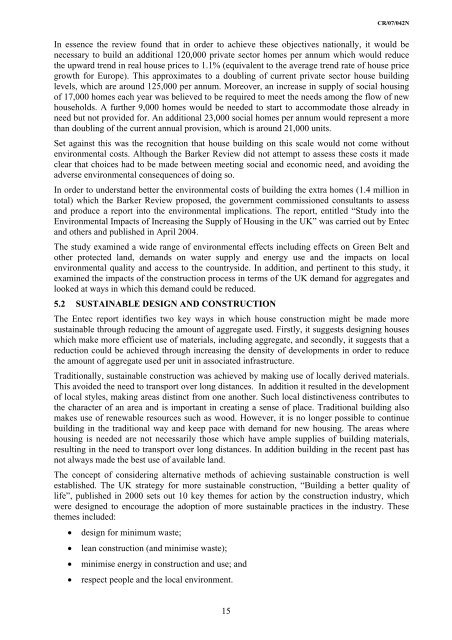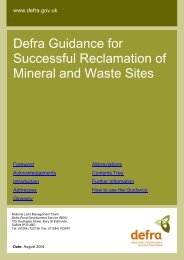Full Report - Sustainable Aggregates
Full Report - Sustainable Aggregates
Full Report - Sustainable Aggregates
You also want an ePaper? Increase the reach of your titles
YUMPU automatically turns print PDFs into web optimized ePapers that Google loves.
CR/07/042N<br />
In essence the review found that in order to achieve these objectives nationally, it would be<br />
necessary to build an additional 120,000 private sector homes per annum which would reduce<br />
the upward trend in real house prices to 1.1% (equivalent to the average trend rate of house price<br />
growth for Europe). This approximates to a doubling of current private sector house building<br />
levels, which are around 125,000 per annum. Moreover, an increase in supply of social housing<br />
of 17,000 homes each year was believed to be required to meet the needs among the flow of new<br />
households. A further 9,000 homes would be needed to start to accommodate those already in<br />
need but not provided for. An additional 23,000 social homes per annum would represent a more<br />
than doubling of the current annual provision, which is around 21,000 units.<br />
Set against this was the recognition that house building on this scale would not come without<br />
environmental costs. Although the Barker Review did not attempt to assess these costs it made<br />
clear that choices had to be made between meeting social and economic need, and avoiding the<br />
adverse environmental consequences of doing so.<br />
In order to understand better the environmental costs of building the extra homes (1.4 million in<br />
total) which the Barker Review proposed, the government commissioned consultants to assess<br />
and produce a report into the environmental implications. The report, entitled “Study into the<br />
Environmental Impacts of Increasing the Supply of Housing in the UK” was carried out by Entec<br />
and others and published in April 2004.<br />
The study examined a wide range of environmental effects including effects on Green Belt and<br />
other protected land, demands on water supply and energy use and the impacts on local<br />
environmental quality and access to the countryside. In addition, and pertinent to this study, it<br />
examined the impacts of the construction process in terms of the UK demand for aggregates and<br />
looked at ways in which this demand could be reduced.<br />
5.2 SUSTAINABLE DESIGN AND CONSTRUCTION<br />
The Entec report identifies two key ways in which house construction might be made more<br />
sustainable through reducing the amount of aggregate used. Firstly, it suggests designing houses<br />
which make more efficient use of materials, including aggregate, and secondly, it suggests that a<br />
reduction could be achieved through increasing the density of developments in order to reduce<br />
the amount of aggregate used per unit in associated infrastructure.<br />
Traditionally, sustainable construction was achieved by making use of locally derived materials.<br />
This avoided the need to transport over long distances. In addition it resulted in the development<br />
of local styles, making areas distinct from one another. Such local distinctiveness contributes to<br />
the character of an area and is important in creating a sense of place. Traditional building also<br />
makes use of renewable resources such as wood. However, it is no longer possible to continue<br />
building in the traditional way and keep pace with demand for new housing. The areas where<br />
housing is needed are not necessarily those which have ample supplies of building materials,<br />
resulting in the need to transport over long distances. In addition building in the recent past has<br />
not always made the best use of available land.<br />
The concept of considering alternative methods of achieving sustainable construction is well<br />
established. The UK strategy for more sustainable construction, “Building a better quality of<br />
life”, published in 2000 sets out 10 key themes for action by the construction industry, which<br />
were designed to encourage the adoption of more sustainable practices in the industry. These<br />
themes included:<br />
• design for minimum waste;<br />
• lean construction (and minimise waste);<br />
• minimise energy in construction and use; and<br />
• respect people and the local environment.<br />
15
















